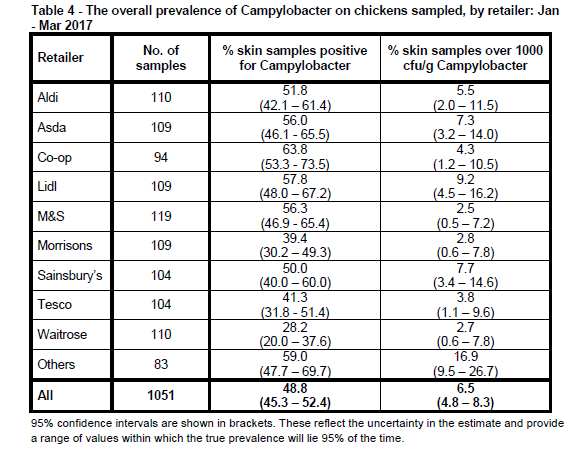The survey on fresh shop-bought UK-produced chickens found a positive rate of 48.8% compared to 50% which tested positive in the same period last year.
The second set of results from the third annual retail survey was based on tests of 1,051 whole fresh chickens sampled during January to March 2017.
Chicken that tested positive for the pathogen at any level was at 56% in the first set of results covering August to December 2016.
Campylobacter reduction progress
Alex Neill, Which? managing director of home products and services, said it was encouraging to see overall levels of Campylobacter in chickens falling and major retailers meeting the FSA’s target.
“However there is no room for complacency as the survey shows that levels can vary greatly depending on where consumers shop and in many cases over half of chickens are still contaminated.”
The figures show 6.5% of chickens tested positive for the highest level of contamination, carrying more than 1,000 colony forming units per gram (cfu/g).
This is down from 9.3% for the same period last year and from 7% compared to the first set of results.
FSA estimated there had been 100,000 fewer cases of Campylobacter in 2016.

Heather Hancock, chairman of the FSA, said levels continuing to go down indicate the major retailers and processors are getting to grips with Campylobacter.
“These results give us a clear picture of the positive direction in which we are heading, and help us measure the impact of interventions that are being used to reduce contamination.
“While results are reassuring, we want to see more progress among the smaller businesses, to achieve real and lasting reductions.”
Changes to the protocol from August 2016 mean samples must comprise 100% neck skin (topping up with breast skin is no longer permitted and samples are smaller (5-10g depending on the amount of available neck skin) compared to the 25g used previously.
Testing was done at the five Public Health England (PHE) Food, Water and Environmental Microbiology Laboratories and the Agri-Food Biosciences Institute (AFBI) in Northern Ireland.
Scottish progress
Meanwhile, data from Health Protection Scotland showed a decline of 15.5% in laboratory reports of human cases of campylobacter in Scotland in 2016, compared to 2015.
Campylobacter is the biggest cause of food poisoning in Scotland and research indicates that 55-75% of human cases are associated with chicken.
Dr Jacqui McElhiney, FSS head of food protection science and surveillance, said UK retailers and poultry producers have made significant improvements in processes to reduce contamination.
“Whilst it is still too early to establish the extent to which we can attribute this decrease to the improvements shown by FSA’s survey results, the trends look encouraging,” she said.
“Scottish consumers should be encouraged that these latest results show further improvement, indicating that the commitment made by the industry to address this important food safety issue is making a real difference.”
